I don't know what I would have done without them They are both Very Protective of me! I don't have enough space here to tell you all Information About The Chow Chow Breed Common Name: Chow Chow The Chow Chow is a one-owner dog My Bear Baby - Age 7 Our God-daughter Samanatha Gets Kisses from Kody Pup Chows are quiet and independent. My Kody Pup - Age 6 Chows will grow to a height of 17 to 20 inches Originating in China, Chows were developed over 2,000 years ago. Specific Care Information: Relative They must be trained at an early age The Chow is prone to, hypothyroidism, hormone problems, We have had none of these problems with our chows. Breeding and Propagation: Relative There are five colors in the Chow: Perhaps, the most unique feature of the Chow HEAD
The Chow's heavy head and muzzle is surrounded by an off-standing ruff. SCOWL The scowl is unique, The tail of the Chow lies on the back GAIT The Chow has only a slight bend of stifle PERSONALITY The Chow Chow is a highly intelligent dog and values his independence. Bear checking out the peacocks My Chow Chows and I Thank You for Visiting!!! Best Chow Chow Resorces Online Breeding, Whelping, Adoptions, Rescue, Dogs.. ...Red Chow...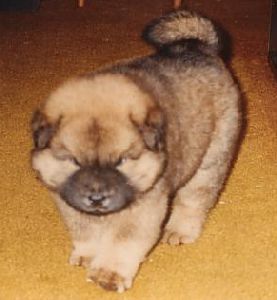
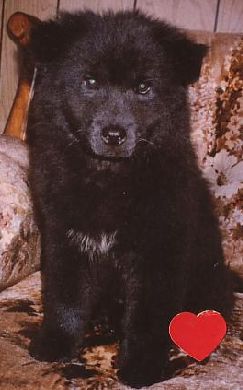
I love my chows.. can't think of being without them.
My red one LOVES the water
but the black one has to be carried to the tub and given a bath.
Weighing in at 65 lbs.. it's Not an easy task I assure you. lol
over the last few years when I was so sick,
they are truly a blessing from God.
the good things about the chow chow breed.
I've had them since they were 5 weeks old.
They love to travel.. And very well behaved.. No matter how long the trip.
Bear the black chow is the boss over the red one..
and not to be messed with, 'teased' at all.
Ohh.. But he has his loving moments.
And they are Sooo Spoiled. :) ..Wonder Why? :)
Scientific Name:
Canis familiaris (Full Taxonomy)
Breed Group: Non-Sporting Group
Origin or Range: China
Relative Size: Average
Average Lifespan: 11 year(s
Compatibility: Relatively Aggressive
Animal Category: Mammals.. Dogs
that will make a good companion if trained properly.
They are a popular and very loyal breed,
I highly recommend them with children
BUT they have to be watched and taught well..
starting at 5 weeks is recommended.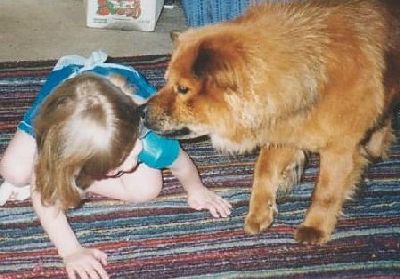
Chows are well behaved compared to other breeds.
Loyal and reserved, they are endearing and possessive.
They are well behaved;
rarely digging or barking excessively,
and they are one of the easiest breeds to housebreak.
Chows have a very different personality than other dogs.
They are cat-like in their attitudes;
they can be aloof, reserved and stubborn,
making them difficult to train.
Obedience and socialization should begin at an early age
to prevent the Chow from becoming dominant or willful.
Though they are not aggressive, their peripheral vision is poor,
so they may bite when you sneak up on them.
They are not known to be playful or eager-to-please,
but they will respond to a strong-willed trainer.
They are vocal when strangers are near,
territorial at times, and fierce if their space is invaded.
Chows require experienced owners,
and they should find a reputable breeder
because they can be aggressive.
Chows are dogs that demand to be treaded respectfully,
and will return the favor to those they see fit.
Since Chows are not 'pack dogs'
they don't enjoy the company of other dogs of the same sex.
and will weigh between 45 and 85 pounds.
Their coats may be smooth or rough.
Their abundant outer coats are straight
and their undercoats are soft and woolly.
Common colors seen on Chows are red,
black, blue, cinnamon, & cream.
The rough-coated chow needs to be brushed daily
and the smooth-coated variety needs to be brushed a few times a week,
especially when shedding.
Their faces seem to scowl, with their wrinkled faces,
small, deeply set eyes, and lion-like collar.
Puppies are born with masks, but they fade with maturity.
Their tails curl over the back.
Chows have small feet and black tongues.
The Chow was used for a variety of tasks
including, protection, hunting, pulling, and herding.
In some instances they have also been used as a food source
and a source of fur.
The Chow Chow is one of the oldest recognizable types of dog,
and their first appearance outside of China
was in England in the late 19th century.
"Chow Chow" was a slang term applied to the cargo of the ships
that carried the dogs from China to England,
and the name stuck to the dogs over time.
Care Ease: Average
Chows need to be brushed at least once a week
to keep their furry coats from matting.
Rough coated chows need to be brushed daily.
to avoid discipline problems throughout their lives.
epilepsy, skin problems, hip dysplasia, bloat and entropion.
The red one had eye surgery because the lower eyelid was turning in.
Breeding Ease: Average
COLORS
red (light golden to deep mahogany),
black, blue, cinnamon (light fawn to deep cinnamon) and cream.
The predominant colors of the Chow are red -- or black.
The reds may be light or dark,
solid throughout or shaded on the tail and breechings.
Less common, the so-called "dilute" colors of cinnamon or fawn
(a dilution of red) or blue (a dilution of black) do exist.
Occasionally a cream will appear, but usually this specimen
has a pink or flesh-colored nose so that it
cannot be shown according to the Chow Chow Club's Breed Standard.
Since the cinnamons and blues are somewhat less common
than the predominant colors of red or black --
an erroneous idea has spread that the cream, cinnamon, and blue Chows
are more difficult to breed and therefore, more valuable.
The dilutes are not actually rare, and the dilute color
has absolutely nothing to do with a dog's value.
The Chow's worth depends not on his color,
but rather on his beauty and excellence
in regard to how closely he approximates the
Chow Chow Club's Breed Standard as recognized by the American Kennel Club.
The pigment in the dilutes is seldom as blue-black
in color as in the red or black Chow.
In the dilutes the pigment may tend to lighten or fade with age.
Often the creamy, pearl-gray color of some cinnamon puppies
will disappear along with the puppy coat,
and the adult color will sometimes not be as attractive
as what was seen in the puppy.
Although blue may sound exotic and be a quite handsome
light blue color in the puppy coat,
such color may turn out to be a rather dirty,
gray-blue-black when the adult coat comes in.
Finally, what should be stressed is that the color
per se of any Chow does not make him any more or less valuable.
TONGUE
is the blue-black color of the tongue and tissues of the mouth,
a characteristic that the Chow shares
with only a few other mammals.
So important is this feature that a Chow with a pink tongue
or a tongue spotted with pink is disqualified
under the Breed Standard and cannot be shown.
Sometimes the words "lion-headed" or "lion-like"
are used to describe the Chow's head.
His eyes are almond shaped & deep set giving him the inscrutable,
mysterious look of an Oriental - quiet and thoughtful.
being one of the most typical characteristics of the Chow,
along with his blue-black tongue and stilted gait.
Although difficult to describe,
the scowl relates to the Chow's frowning expression.
Excessive loose skin is not desirable.
Wrinkles on the muzzle do not contribute
to the expression and are not required.
The shadings make the scowl much more noticeable
in the reds than in the other colors.
The scowl sometimes erroneously suggests to some
that the Chow is mean or temperamental;
of course, outward appearances have little to do
with any breed's temperament or personality.
TAIL
and is a most decorative part of the Chow
contributing to his beauty and handsome appearance.
Thick at its root, tapering off to the tip,
the tail should be high set.
and is straight in hocks rather than angulated.
Therefore, his unusual rear gait appears choppy and stilted.
His steps are short and quick.
He does not put his hind legs very far forward
nor very far backward as most breeds do.
Having a short and lilting step,
owing to the hock and stifle joints having so little angulation,
the Chow moves his hind legs somewhat like stilts.
In spite of this unusual gait,
the Chow can move rapidly and should have a lot of endurance.
He can be hugged and played with.
He can even be corrected -often by a tone of voice,
but he should never be allowed to dominate the household.
He is usually amenable to being touched by strangers
if he is introduced by one of his owners and approached properly.
Quiet, refined, he should not be teased or treated as a lap dog.
His dignity and aloofness must never be confused
with a fierce or intractable temperament.
He minds his own business & does not generally initiate trouble.
Bad-tempered Chows are not representative of the breed,
but are usually the result of indiscriminate breeding
and a woeful lack of "socialization".
The Chow's appearance and personality suggest the nobility of a lion,
the drollness of a panda, the appeal of a teddybear,
the grace and independence of a cat,
and the loyalty and devotion of the dog.
The Chow has a little of all these qualities
in his appearance and in his behavior.
It is, however, his particular intelligence and devotion,
his independence and dignity which make him unique.
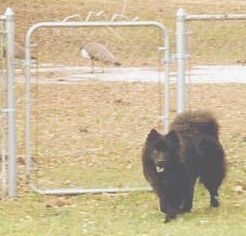
More of our Chow pictures
will be added as time permits!
Chow Links
~* Friends Dogs Pages *~...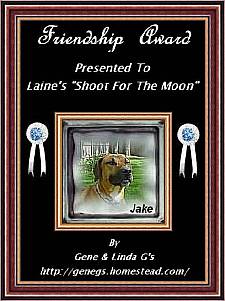

![]()
![]()
